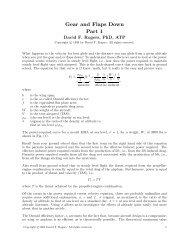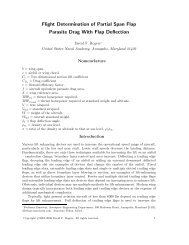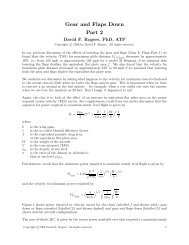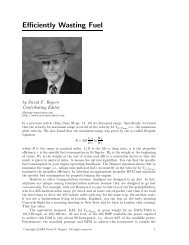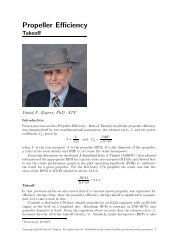Airspeed David F. Rogers
Airspeed David F. Rogers
Airspeed David F. Rogers
Create successful ePaper yourself
Turn your PDF publications into a flip-book with our unique Google optimized e-Paper software.
Total Pressure<br />
Port, P<br />
Pitot Probe<br />
Static Pressure Port, P Static<br />
<strong>Airspeed</strong><br />
Indicator<br />
Figure 1.<br />
Schematic of a separate pitot-static source system.<br />
calibrated using the density at sea level on a standard day, i.e. ρ SSL =0.002378 slugs/cubic foot.<br />
Consequently, the ASI seldom, if ever, reads the actual velocity (TAS) of the aircraft. As a result,<br />
Equation(2) reduces to<br />
V = Constant √ P Total − P Static (3)<br />
How do you find TAS What does the ASI read Figure 2 illustrates the process of correcting<br />
the number read off the ASI, called Indicated AirSpeed (IAS), to give TAS. First, no instrument<br />
reads precisely the correct value even with precisely the correct input. The difference between the<br />
actual value and the indicated value is called instrument error. In essence this is a mechanical<br />
problem. The POH assumes zero instrument error. Consequently, in Figure 2 instrument error is<br />
lumped together with position error.<br />
Position error results from incorrect pressure values read by the pitot probe and the static<br />
ports. Except at very high angles of attack, the pitot probe is quite accurate. However, the static<br />
pressure port can be very inaccurate. What we want the static pressure port to measure is the<br />
atmospheric pressure well ahead of the aircraft, i.e., in what is called by aeronautical engineers<br />
the free stream. Obviously, we cannot do this directly without sticking a long probe out ahead of<br />
the airplane. Except on flight test aircraft, that is neither a good nor a practical idea. Instead,<br />
aeronautical engineers look for a position on the aircraft that gives the same static pressure reading<br />
as that in the free stream. This is not easy to do. No matter where you locate the static pressure<br />
port(s), the static pressure reading depends on the aircraft configuration and flight attitude, e.g.,<br />
clean, gear down, flaps down, gear and flaps down, high angle of attack, slipping or skidding. For<br />
late model Bonanzas, the POH shows that in the clean configuration the position error is about<br />
Correct for instrument<br />
and position errors<br />
Correct for<br />
compressibility<br />
Correct for<br />
density altitude<br />
IAS CAS EAS TAS<br />
Figure 2.<br />
Corrections to IAS that yield TAS.<br />
Copyright c○1999 <strong>David</strong> F. <strong>Rogers</strong>. All rights reserved. 2



